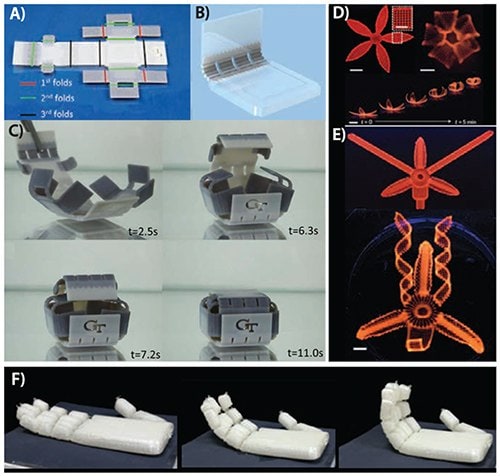4D Printing: The Next Step in Manufacturing
Written by: Jonathan Handjojo
Imagine a world where materials don’t just hold their shape after being printed—they evolve, transforming in response to their environment. This is the world of 4D printing, a groundbreaking innovation that builds on the capabilities of traditional 3D printing by introducing a fourth dimension: time. By using advanced materials that morph in response to external stimuli like temperature, humidity, or voltage, 4D printing creates programmable matter that can reshape itself after its initial creation. From manufacturing to biomedical engineering, this technology can reshape industries and solve longstanding problems in fields like transportation, medicine, and more. But how does it work, and what is the science behind it?
The Technology Behind 4D Printing
At its core, 4D printing is an evolution of established 3D printing principles, which use methods like Fused Deposition Modeling (FDM) or stereolithography to layer and create solid, static objects. The real magic of 4D printing lies in its materials—polymers designed to dynamically respond to changes in the environment. Stereolithography is a 3D-printing technique that uses photopolymerization to bind substrate that has been laid layer upon layer, creating a polymeric network. 4D printing is fundamentally based in stereolithography, where UV light is usually used to cure layered materials. By embedding directionality when printing (anisotropy), scientists can control how an object will transform in specific ways when exposed to different stimuli, making the print “4D.” Since 4D-printed parts can also be designed on the macro or micro scale, fiber networks of both rigid and reactive polymers are used to approximate the aggregated material properties of all the materials used in the sample. These fibers vary in size, shape, and composition, and they form the foundation of how 4D-printed objects deform in response to external stimuli.
Figure 1

A composite polymer that folds when submerged in water (≈450x speed)
Source: Self-Assembly Lab – MIT
Materials Used
4D printing mainly relies on 2 types of materials, hydrogels and shape-memory polymers (SMPs). Hydrogels are polymers that swell or contract when exposed to different levels of moisture or temperature. By combining a rigid hydrogel layer with a flexible one, researchers created double-network hydrogels that can repeatedly transform without losing strength or durability. This durability is crucial for its applications in soft robotics and biomedical devices, allowing them to have long-term reliability.
Shape-memory polymers, on the other hand, can “remember” their original shape, returning from a deformed state in response to a particular stimulus. SMPs are particularly attractive for 4D printing because they can be programmed to shift between shapes in a controlled, predictable manner. This characteristic makes them ideal for a wide range of applications, from self-healing materials and deployable structures to medical devices that adjust their form within the body, such as stents or drug-delivery systems.
Figure 2

A–B) The folding box is designed with different materials assigned to different hinges. C) Programmed 3D printed sheet folds into a box with a self-locking mechanism upon heating. Copyright 2015, rights managed by Nature Publishing Group. D–E) Swollen flower structures generated by biomimetic 4D printing with composite hydrogel and cellulose fibrils. Copyright 2016, rights managed by Nature Publishing Group. F) Temperature-responsive TPU filament artificial hand.
Source: MilliporeSigma
Applications
Due to its versatility, 4D printing has enormous potential for applications in many fields, especially commercial and industrial applications. With this technology, we could make shipping containers made from 4D-printed materials and adjust their structure during transit to distribute loads more efficiently or self-repair in case of damage. Products could be shipped flat and activated to take on their final shape at the delivery site, reducing shipping costs and environmental impact. Some 4D printed materials might even be able to self-disassemble for easier recycling. Shoes that can make themselves, adapt to movement, impact temperature, and atmospheric pressure. Even the U.S. military is testing using 4D printing to create uniforms that change color depending on the environment or regulate sweat depending on the soldier’s pulse or outside temperature.
On a more biological side, inspired by nature, researchers are also working on making structures that mimic the behavior of plant cells, which change shape in response to external stimuli like light or humidity. This has led to the creation of hydrogels that mimic the internal structure of plant cell walls, allowing for highly controlled shape changes. In the biomedical industry, 4D-printed scaffolds are being developed for tissue engineering. Researchers at George Washington University have pioneered the use of 4D-printable soybean-based resins to create biocompatible scaffolds that can support cell growth. These scaffolds retain their shape even under extreme temperature changes, making them ideal for medical applications such as tissue regeneration.
Conclusion
As exciting as 4D printing is, it’s still a developing field. Researchers are fine-tuning the behavior of smart materials and working out how to scale up these technologies for widespread use. But its potential is huge: think skyscrapers that can shift and adapt to environmental conditions, medical devices that would evolve within a patient’s body, or infrastructure adjusting to varying loads in real time. The only boundary is our imagination. Today, we are standing at the threshold of a new frontier in design and material science. Tomorrow, who knows what might unfold? In 4D printing, the future is anything but fixed.
References and Sources
Do you know what the Fourth Industrial Revolution will be? (n.d.). Iberdrola. https://www.iberdrola.com/innovation/what-is-print-4d
Sigma Aldrich. (2024). NMR Chemical Shifts of Impurities Charts. Merck, 1(1). https://www.sigmaaldrich.com/MX/en/technical-documents/technical-article/genomics/cloning-and-expression/blue-white-screening
StackPath. (n.d.). Www.machinedesign.com. https://www.machinedesign.com/3d-printing-cad/article/21837454/4d-printing-a-revolution-across-industries
Tibbits, S. (2014). 4D Printing: Multi-Material Shape Change. Architectural Design, 84(1), 116–121. https://doi.org/10.1002/ad.1710